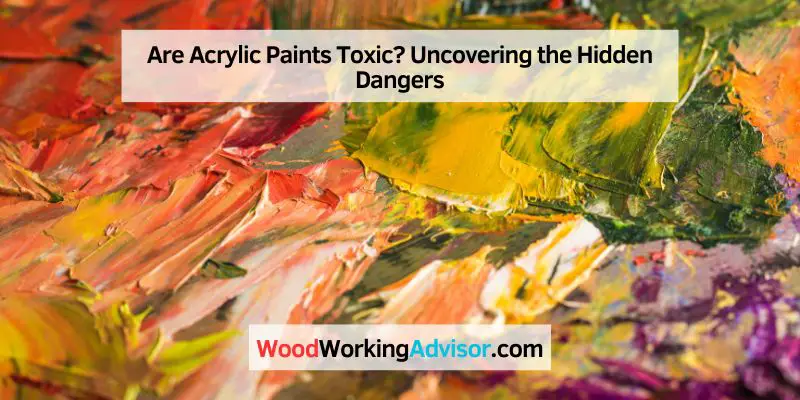Acrylic paints can be toxic due to the presence of harmful chemicals, such as ammonia and formaldehyde. Acrylic paints have gained significant popularity among artists and hobbyists due to their vibrant colors and versatile nature.
However, it is essential to understand the potential toxicity associated with these paints. Acrylic paints can contain harmful chemicals like ammonia and formaldehyde, which can be toxic when inhaled or directly ingested. These chemicals can lead to various health issues, including respiratory problems, skin irritation, and even long-term complications.
Therefore, it is crucial to handle acrylic paints with care, ensuring proper ventilation and avoiding direct contact with the skin or ingestion. By taking these precautions, artists can continue to enjoy the benefits of acrylic paints while minimizing the potential health risks.
The Truth About Acrylic Paints
Are acrylic paints toxic? This is a common question among artists and hobbyists who enjoy working with these vibrant and versatile paints. In order to make an informed decision about using acrylic paints, it’s important to understand the ingredients to watch out for and the potential health risks associated with them.
Ingredients To Watch Out For
Acrylic paints are typically made from a pigment suspended in an acrylic polymer emulsion. While acrylic paints are generally considered safe to use, there are certain ingredients that you should be aware of, especially if you have sensitivities or allergies.
One ingredient to watch out for is cadmium, a heavy metal that is commonly used to create bright, opaque colors. Cadmium pigments have been found to have potential carcinogenic properties, meaning they may be linked to the development of cancer. It’s important to note that the risk of exposure to cadmium is highest when working with cadmium-based pigments in their powdered or aerosol form.
Another ingredient to be mindful of is formaldehyde, a substance used as a preservative in some acrylic paints. While the levels of formaldehyde in acrylic paints are typically low and considered safe for most people, individuals with asthma or chemical sensitivities may experience adverse reactions.
Potential Health Risks
Overall, if used properly and with proper ventilation, acrylic paints are generally safe and pose minimal health risks. However, it’s important to take necessary precautions to protect yourself. Here are some potential health risks to be aware of when using acrylic paints:
- Irritation: Acrylic paints can cause skin and eye irritation, particularly if you come into direct contact with them or inhale their fumes. It’s important to wear protective gloves and goggles, and work in a well-ventilated area.
- Allergies: Some individuals may develop allergies or sensitivities to certain pigments or additives in acrylic paints. If you notice any allergic reactions, such as itching, redness, or rash, it’s best to discontinue use.
- Respiratory Issues: Inhaling the fumes or dust particles from acrylic paints can irritate the respiratory system, leading to coughing, wheezing, or shortness of breath. Again, proper ventilation is key to minimize these risks.
It’s important to emphasize that the potential health risks associated with acrylic paints are generally low when precautions are taken. By using protective gear, working in a well-ventilated space, and being aware of potential allergens, you can safely enjoy the vibrant world of acrylic painting.

Credit: sponauglewellness.com
Safety Precautions
When working with acrylic paints, it is important to prioritize safety to protect both yourself and the environment. Certain precautions should be taken to minimize any potential risks associated with these paints. In this section, we will discuss two key safety measures you should consider: proper ventilation and the use of protective gear.
Proper Ventilation
Adequate ventilation is crucial when using acrylic paints as it helps to minimize the inhalation of potentially harmful fumes and particles. Ensure you are working in a well-ventilated area, such as a room with open windows or a studio equipped with a ventilation system. If working outdoors, be mindful of wind conditions that may cause paints to disperse in unpredictable ways.
Opening windows or using a fan can improve air circulation, aiding in the dispersion of fumes. Consider using a portable air purifier to further enhance air quality by removing any lingering particles.
Protective Gear
Wearing protective gear while working with acrylic paints is vital to safeguard your health. It is recommended to invest in the following protective equipment:
- Gloves: Use disposable gloves to prevent direct contact between the paint and your skin. Latex or nitrile gloves are both suitable options.
- Eye Protection: Wear safety goggles or a face shield to shield your eyes from accidental splashes or airborne particles.
- Apron or Lab Coat: Protect your clothing by wearing an apron or lab coat specifically designated for painting.
- Dust Mask: Consider using a dust mask when sanding or working on dry pigments to avoid inhaling fine particles.
Remember to dispose of gloves and masks properly after each use to prevent any potential contamination.
By adhering to these safety precautions, you can enjoy your acrylic painting experience with peace of mind, knowing that you have taken measures to protect yourself and maintain a safe environment.
Alternative Non-toxic Options
Acrylic paints may contain toxic chemicals, but you have alternative non-toxic options available. These paints are made with natural and non-toxic ingredients, providing a safer and healthier painting experience. Look for water-based or plant-based alternatives to reduce your exposure to harmful substances.
Natural And Organic Paints
For those looking to avoid toxic chemicals in paint, natural and organic options are a great alternative. Coat your canvas with paint made from ingredients like plant-based pigments and natural oils. These paints are free from volatile organic compounds (VOCs) and other harmful additives, making them safe for both artists and the environment. Plus, you’ll enjoy the added benefit of supporting sustainable and eco-friendly practices by using these natural and organic paints.
Water-based Alternatives
Consider opting for water-based paints as a non-toxic alternative to acrylics. These paints utilize water as a primary solvent, resulting in low toxicity levels. Moreover, they offer easy cleanup with water and soap, eliminating the need for harsh chemical solvents. By choosing water-based alternatives, you can minimize your exposure to toxic substances while still achieving vibrant and long-lasting artwork.
When it comes to painting, there are plenty of options to choose from. By exploring natural and organic paints as well as water-based alternatives, you can create stunning artwork without compromising your health or the environment.
Health Implications
Acrylic paints may pose health risks due to the toxic chemicals used in their production, which can lead to respiratory issues and skin irritation. It is important to handle these paints in a well-ventilated area and take necessary precautions to minimize exposure.
Acrylic paints are widely used by artists for their vibrant colors and quick drying properties. However, concerns have been raised about the potential health implications of these paints. In this section, we will explore the long-term effects of acrylic paints and their impact on artists’ health.
Long-term Effects:
Overexposure to acrylic paints can have long-term effects on an artist’s health. The paints contain various chemicals that can be harmful if inhaled or absorbed through the skin over a prolonged period. Some of the known long-term effects include:
1. Respiratory Issues: Continuous exposure to acrylic paint fumes can lead to respiratory problems such as asthma, bronchitis, and shortness of breath.
2. Skin Irritation: The chemicals present in acrylic paints can cause skin irritation and allergic reactions, especially in individuals with sensitive skin.
3. Organ Damage: Prolonged exposure to certain toxic substances found in acrylic paints can lead to damage to internal organs such as the liver and kidneys.
4. Cancer Risk: Some acrylic paints contain heavy metals and other additives that have been linked to an increased risk of cancer, particularly in cases of chronic exposure.
Impact On Artists:
Artists who regularly work with acrylic paints are at a higher risk of experiencing health issues associated with exposure to these paints. Some specific impacts include:
1. Artistic Respiratory Syndrome (ARS): Artists who frequently inhale acrylic paint fumes may develop ARS, which is characterized by symptoms such as coughing, wheezing, and chest tightness.
2. Allergic Reactions: Artists with a sensitivity to certain chemicals in acrylic paints may develop allergic reactions, ranging from mild skin rashes to severe swelling and difficulty breathing.
3. Occupational Dermatitis: Continuous contact with acrylic paints can cause occupational dermatitis, resulting in redness, itching, and inflammation of the skin.
4. Eye Problems: Artists who don’t use adequate eye protection while working with acrylic paints may experience eye irritation, redness, and even vision problems in extreme cases.
To minimize the potential health risks associated with acrylic paints, artists should take precautions such as working in a well-ventilated area, using protective gear like masks and gloves, and maintaining good personal hygiene by washing hands thoroughly after painting sessions. Additionally, artists should consider using water-based or low-toxicity acrylic paints as alternatives, which can be less harmful without compromising on the quality of their artwork.
Regulatory Measures
Regulatory measures play a crucial role in ensuring that acrylic paints are safe for use. These measures include industry standards and government regulations that dictate the composition and labeling requirements of acrylic paints. In this blog post, we will explore these regulatory measures in detail and gain a better understanding of the safety of acrylic paints.
Industry Standards
Industry standards are guidelines and benchmarks that regulate the manufacturing, labeling, and composition of acrylic paints. These standards are established by organizations such as the American Society for Testing and Materials (ASTM) and the International Organization for Standardization (ISO).
The industry standards for acrylic paints focus on various aspects, including:
- The maximum allowable levels of toxic substances
- Labeling requirements to provide essential information to consumers
- Safety precautions during storage, handling, and disposal
Government Regulations
Government regulations play a critical role in ensuring the safety and compliance of acrylic paints. These regulations are set by government bodies such as the Environmental Protection Agency (EPA) and the Consumer Product Safety Commission (CPSC). They are designed to protect consumers and the environment from the potential harm associated with toxic substances.
Government regulations related to acrylic paints typically cover:
- Testing and certification of paints to ensure safety
- Restrictions on the use of toxic substances
- Proper labeling and warnings for consumers
- Monitoring and enforcement of compliance
Adherence to government regulations is essential for manufacturers, distributors, and retailers of acrylic paints to ensure that their products meet the required safety standards.

Credit: www.walmart.com
Frequently Asked Questions For Are Acrylic Paints Toxic
What Are The Dangers Of Acrylic Paint?
Acrylic paint can pose dangers due to its toxic chemicals, such as formaldehyde and ammonia, which can cause skin irritation, respiratory issues, and even asthma symptoms. Additionally, the fumes emitted during painting can be harmful if inhaled. It’s advisable to use proper ventilation and protective gear when working with acrylic paint.
Is 100% Acrylic Paint Toxic?
Acrylic paint is non-toxic when used as directed. However, some pigments may contain harmful chemicals. Ensure proper ventilation and avoid ingesting or prolonged skin contact. Always read the safety labels and handle with care.
Is It Safe To Use Acrylic Paint Indoors?
Yes, it is safe to use acrylic paint indoors. It dries quickly, emits low levels of fumes, and is non-toxic. Just ensure proper ventilation and use it according to the manufacturer’s instructions.
Is Acrylic Paint Safe For Kids?
Yes, acrylic paint is safe for kids. It is non-toxic and water-based, making it easy to clean up. Always supervise young children and ensure proper ventilation when using paint. Remember to cover surfaces to avoid stains and protect clothing with aprons or smocks.
Conclusion
While acrylic paints can contain toxic chemicals, there are non-toxic options available. It is important to be mindful of ventilation and skin contact. Considering the possible health risks, it’s smart to opt for safer alternatives and follow safety guidelines when using acrylic paints.
Make informed choices to ensure a healthier creative process.


